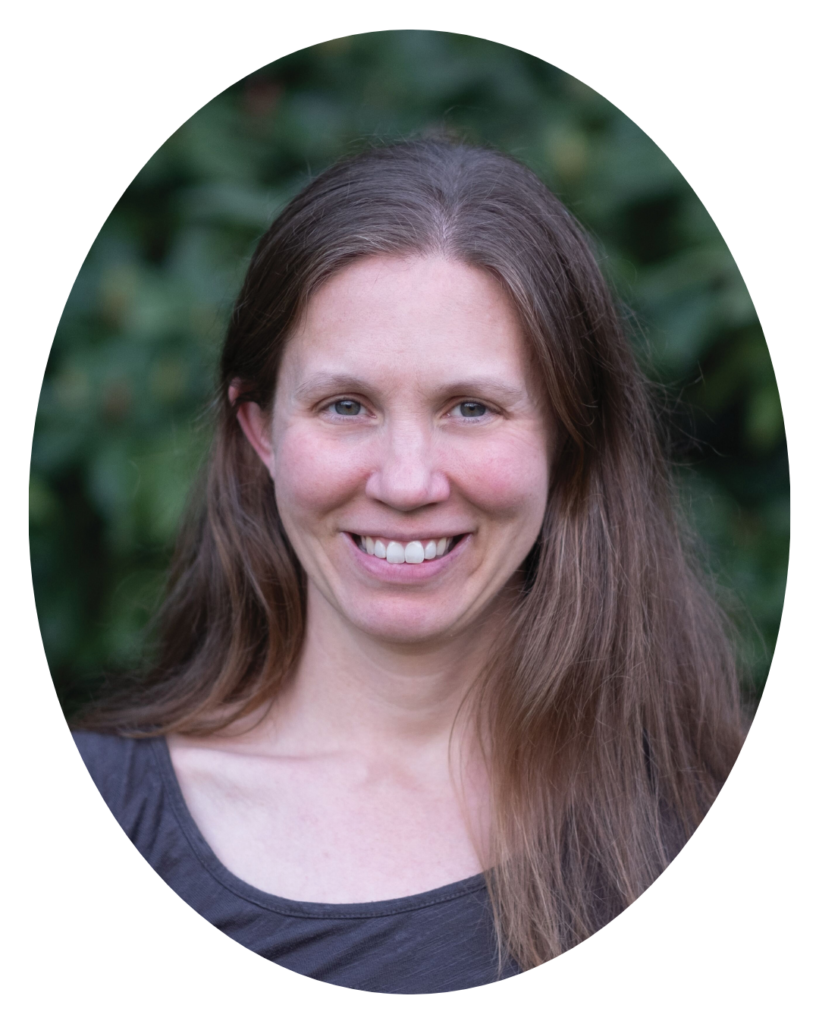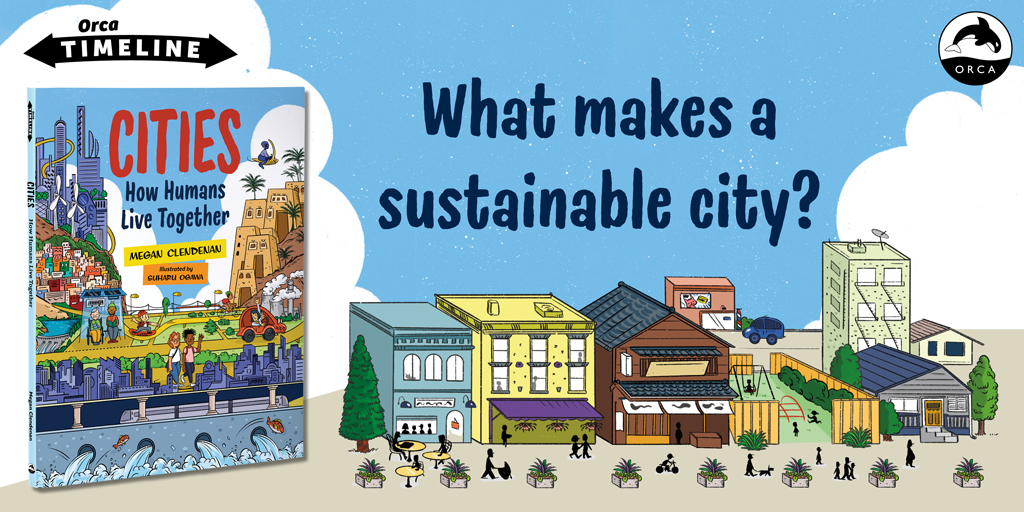“Truly impressive…An engaging presentation of information that might otherwise be seen as technical and mundane. Recommended.”
– School Library Connection
Cities face big challenges, including threats from climate change, food insecurity, a lack of clean water and rapid population growth, but they are also places where innovation and sustainability can thrive.
Cities: How Humans Live Together travels through time to explore questions like When and why did cities form? How did people access food and water? Where did they go to the bathroom? Peek into the past to see how cities have changed through time and explore what could make cities more sustainable and welcoming for today and tomorrow.
We sat down with Cities author Megan Clendenan to ask her some questions about her new book, including what makes a successful city.
Your new book is a nonfiction book for middle-grade readers all about the past, present and future of cities and, importantly, how sustainability can play an important role in how humans chose to live. What inspired you to explore this topic and why specifically for young readers?
At university, one of the subjects I studied was environmental urban planning, but after graduation, I embarked on a different professional route, one that would allow me to focus on research and writing. But I’ve remained curious and interested in cities and urban planning, and always have a lot of questions. What was it like to live in a city in the past? How do people choose what city to live in? Is it because they are a good place to live or is it because they had/have no choice? Now that I write non-fiction for young readers, I felt like it was a perfect opportunity to bridge my studies and my personal interest in cities. The result is this book! I chose to write for readers aged 9–12 for a few reasons. My own son is that age, and so I experience conversations daily with this age group. I love how full of wonder and curiosity they are, with great questions and an openness to learning about the world.
What are some things that make a successful and welcoming city?
Research has found that people are happier living in cities where they feel safe, are able to travel easily for their daily activities, have nearby green space to enjoy nature, and feel welcomed in their community. They also need safe water to drink, clean air to breathe, and healthy food that they can access and afford to buy. Cities that invest in accessible public transportation, bike lanes, water filtration, garbage/compost/recycling programs, green spaces, as well as community spaces like community centers and libraries are on the right track to being successful and welcoming. In the book, I profile a number of cities to highlight what makes them successful. On the flip side, I also provide examples that show what happens when a city is not welcoming, and these provide good points of discussion as well.
Why is it so important that cities are sustainable? Can you share some examples of innovative design or technology from cities that are working towards these goals?
Today about half of the world’s population live in cities. By 2050, an estimated 70% of people will live in cities, so how sustainable cities are plays a big role in overall global sustainability. Right now, cities produce at least 60 percent of global greenhouse gas emissions, and they also face challenges due to climate change, such as extreme weather events like heat waves, floods, and ice storms. Many cities struggle with poor air quality and unsafe water, as well as traffic issues. The more sustainable cities can become, the better for our planet, our health and our quality of life. In the book, I feature a number of exciting new innovations, as well as some excellent ideas from the past that might help cities become more sustainable in the future. For example, New York City is building reefs of oysters in the harbor to create natural infrastructure to help protect the city from big storms, such as 2012’s Superstorm Sandy. In Shanghai, they are replacing concrete embankments with wetlands to help soak up storms, reduce flooding, and help cool the city during hot months. In Copenhagen, they have built more than 250 miles (400 km) of bike paths and that’s how the majority of city residents travel about their city. Availability of fresh water is another major issue for cities. In Singapore and a number of other cities, they have returned to the ancient practice of rainwater harvesting, building modern rainwater catchment systems to capture the rain instead of having it fall into the sewers. There are many more examples of sustainability in the book, it’s definitely an exciting subject with a lot of possible solutions.
What’s one cool or unexpected fact that you learned while researching this book?
There were ancient toilets and taps! In my research on ancient cities, I learned that a number had indoor plumbing systems, including running water, flushing toilets and sewer systems. It wasn’t the same as our modern equivalent, but the basic ideas of water management were invented much earlier than I had realized, though it certainly hasn’t been used consistently through time or across all cities. I also provide some thought-provoking examples in the book of what happens when water and waste are not managed properly.
If you could live in any city in the world, which one would it be, and why?
Copenhagen, Denmark for the biking culture or Buenos Aires, Argentina for the amazing parks are both top contenders, but I’d probably choose where I live now, in Vancouver, BC. Vancouver has some downsides: it’s expensive and it has some big traffic problems. Oh, and it does rain a lot! But it also has a lot of upsides: it’s a city close to mountains, forests, and the ocean. It has a number of bike lanes and walkable neighborhoods, and it also has a great diversity of people and food. The city has shared spaces like parks, walking paths, libraries and community centers. There’s also a number of community gardens (though more would be better!). I guess there’s no place like home!
Your book features bright and fun illustrations by Suharu Ogawa. Do you have a favorite illustration or spread?
I love all the illustrations by Suharu Ogawa. They lend a fun atmosphere and provide visual details that complement and enhance the text, which I am so grateful for. The cover illustration is one of my favorites. It’s the kind of detailed illustration that you can look at time and time again, and still find new little nuggets that you hadn’t noticed before. That’s the kind of illustration I loved as a child, and I guess I still do.
What do you hope readers will take away from reading this book?
I hope that this book sparks questions, discussion and curiosity about how humans live together in cities, and what the challenges and solutions might be for the future. At the end of the book I invite readers to ‘Imagine the City You’d Like to Call Home’. I offer some suggestions on what a welcoming and sustainable city might be, but I also see this page as an opportunity for readers to offer their own ideas, insight and opinions on what makes a great city to live in.
This is now your third nonfiction title, following Fresh Air, Clean Water: Our Right for a Healthy Environment and Design Like Nature: Biomimicry for a Healthy Planet. What is next for you, is there another topic you are itching to dig into?
I’m excited to be writing another book for the Orca Timelines series. It explores the history of how and what humans ate through time, and focuses on difficult and unique situations such as during war or building massive monuments such as the Pyramids, and it also looks at how we might innovate our food habits for the future. I love learning about food systems so this is a fun project for me to work on.

Megan Clendenan has lived in cities of all sizes and loves to explore new neighborhoods on foot. She has worked for women’s rights, mental health and youth empowerment nonprofit organizations as well as for an environmental law group. Megan is the author of Fresh Air, Clean Water, part of the Orca Think series; co-author of Design Like Nature, part of the Orca Footprints series; and the author of Offbeat, a novel for young readers. Megan lives near Vancouver, British Columbia, with her family.
Photo by Dave Clendenan.

